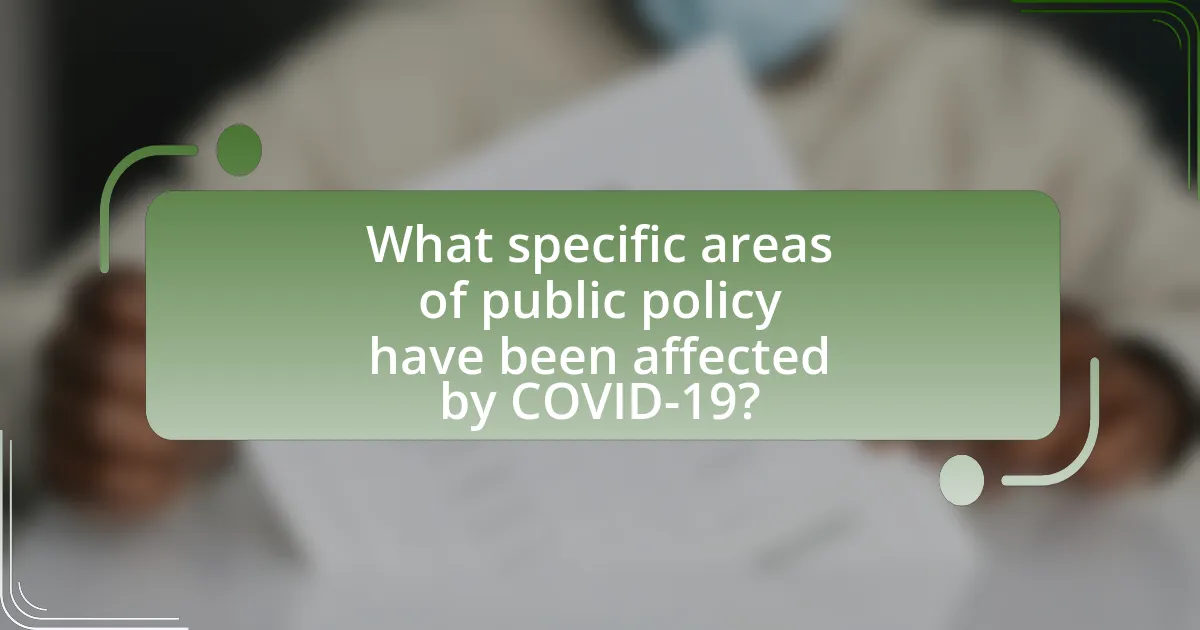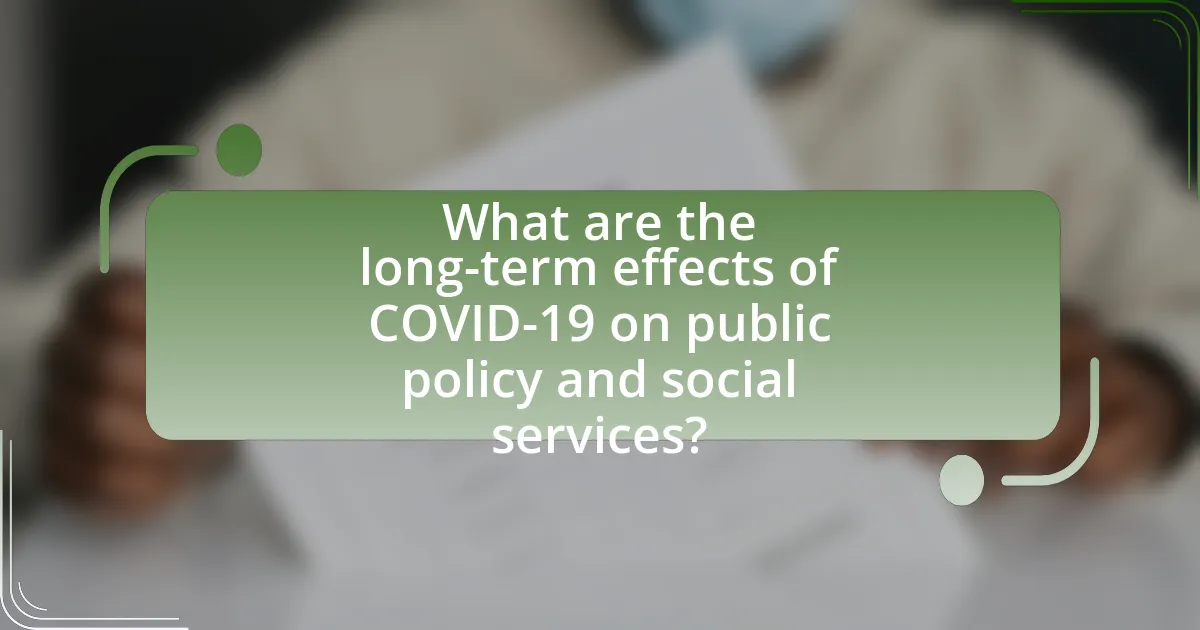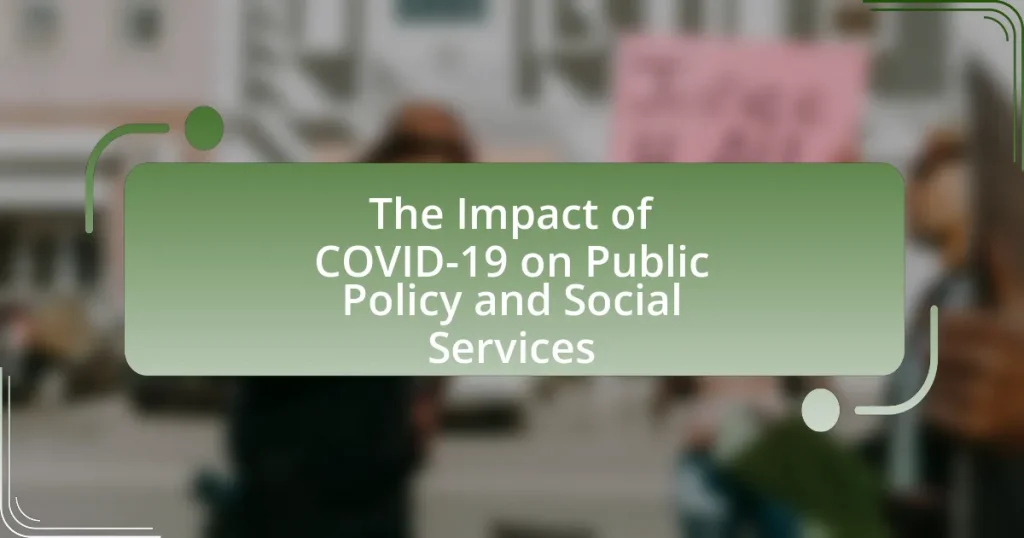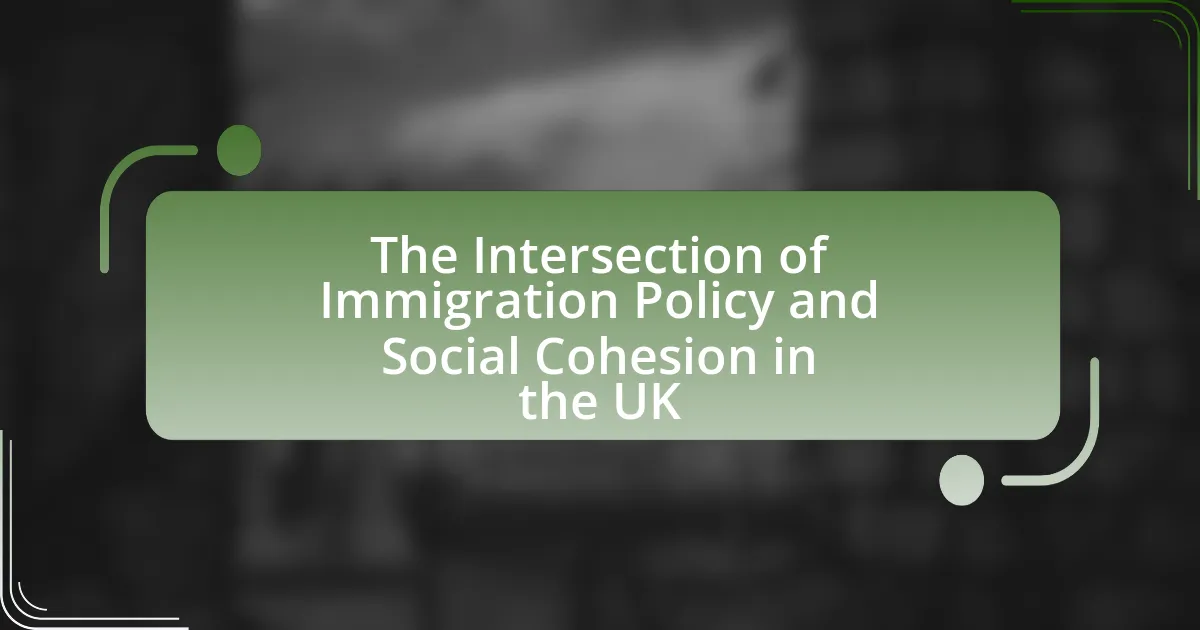The article examines the significant impact of COVID-19 on public policy and social services, highlighting the profound changes in government responses and service delivery. It discusses the implementation of emergency measures, such as the CARES Act in the U.S., which provided substantial economic relief, and the increased demand for social services due to rising unemployment and health concerns. The article also explores how existing policies were modified, the challenges faced by social services, and the long-term implications for public policy frameworks, including healthcare, education, and economic policy. Additionally, it emphasizes the importance of understanding these changes for future policy-making and the need for adaptive, evidence-based approaches to address emerging social needs.

What is the Impact of COVID-19 on Public Policy and Social Services?
The impact of COVID-19 on public policy and social services has been profound, leading to significant changes in government responses and service delivery. Governments worldwide implemented emergency measures, such as lockdowns and social distancing, which necessitated rapid adaptations in public policy to address health crises and economic fallout. For instance, the U.S. enacted the Coronavirus Aid, Relief, and Economic Security (CARES) Act, providing over $2 trillion in economic stimulus to support individuals and businesses. Additionally, social services faced increased demand due to rising unemployment and health concerns, prompting expansions in programs like unemployment benefits and food assistance. Research from the World Bank indicates that the pandemic has pushed millions into poverty, highlighting the urgent need for effective social safety nets and responsive public policies.
How has COVID-19 reshaped public policy frameworks?
COVID-19 has significantly reshaped public policy frameworks by accelerating the adoption of digital services and emphasizing the importance of public health infrastructure. Governments worldwide have implemented policies that prioritize health security, such as increased funding for healthcare systems and the establishment of emergency response protocols. For instance, the World Health Organization reported that countries like New Zealand and South Korea effectively utilized technology for contact tracing and public communication, which became integral to their pandemic response strategies. Additionally, the crisis highlighted the need for social safety nets, leading to expanded unemployment benefits and direct financial assistance programs in various nations, as seen in the United States with the CARES Act. These changes reflect a broader shift towards more responsive and adaptive governance in the face of global health challenges.
What specific policies were introduced in response to the pandemic?
Governments worldwide introduced various specific policies in response to the COVID-19 pandemic, including lockdown measures, travel restrictions, and economic stimulus packages. Lockdown measures mandated the closure of non-essential businesses and schools to limit virus transmission, while travel restrictions aimed to control the spread of the virus across borders. Economic stimulus packages, such as direct financial assistance to individuals and businesses, were implemented to mitigate the economic impact of the pandemic. For instance, the United States enacted the Coronavirus Aid, Relief, and Economic Security (CARES) Act, which provided over $2 trillion in economic relief. These policies were critical in addressing public health concerns and supporting economic stability during the crisis.
How have existing policies been modified due to COVID-19?
Existing policies have been modified due to COVID-19 by implementing emergency measures that prioritize public health and economic stability. Governments worldwide have enacted policies such as temporary moratoriums on evictions, expanded unemployment benefits, and increased funding for healthcare systems to address the pandemic’s immediate impacts. For instance, the U.S. government passed the Coronavirus Aid, Relief, and Economic Security (CARES) Act, which provided direct financial assistance to individuals and businesses, illustrating a significant shift in fiscal policy to support those affected by the crisis. Additionally, many countries have adapted their public health policies to include mandatory mask-wearing and social distancing guidelines, reflecting a rapid response to the evolving health crisis.
What are the implications for social services during the pandemic?
The implications for social services during the pandemic include increased demand for services, challenges in service delivery, and heightened vulnerability among marginalized populations. Social services faced a surge in requests for assistance due to job losses and health crises, with the U.S. Census Bureau reporting that 30% of households experienced a loss of income during the early months of the pandemic. Additionally, social distancing measures disrupted traditional service delivery methods, forcing agencies to adapt to remote operations, which often limited access for those without technology. Vulnerable groups, such as low-income families and individuals with disabilities, experienced exacerbated hardships, highlighting the need for targeted interventions and policy adjustments to address these challenges effectively.
How has service delivery changed in response to COVID-19?
Service delivery has significantly shifted in response to COVID-19, primarily through the acceleration of digital services and remote access. Governments and organizations rapidly adopted online platforms to ensure continuity in service provision, leading to a 70% increase in telehealth services and a substantial rise in e-governance initiatives. For instance, the World Health Organization reported that many countries transitioned to virtual consultations to maintain healthcare access while adhering to social distancing measures. This transformation not only improved accessibility but also highlighted the need for robust digital infrastructure in public service delivery.
What challenges have social services faced during the pandemic?
Social services have faced significant challenges during the pandemic, including increased demand for services, staffing shortages, and disruptions in service delivery. The surge in unemployment and economic instability led to a higher number of individuals seeking assistance, straining resources. Staffing shortages arose due to illness, burnout, and the need for remote work adaptations, which hindered service provision. Additionally, social distancing measures and lockdowns disrupted traditional methods of service delivery, making it difficult to reach vulnerable populations. According to a report by the National Association of Social Workers, 70% of social workers reported increased workloads during the pandemic, highlighting the strain on the system.
Why is understanding this impact important for future policy-making?
Understanding the impact of COVID-19 is crucial for future policy-making because it provides insights into the effectiveness of existing policies and highlights areas needing improvement. For instance, the pandemic revealed significant gaps in healthcare systems, as evidenced by the increased mortality rates in countries with underfunded public health services. By analyzing these outcomes, policymakers can develop more resilient frameworks that prioritize health equity and preparedness for future crises. Additionally, understanding the socio-economic repercussions, such as the rise in unemployment and mental health issues, allows for targeted interventions that address the needs of vulnerable populations, ensuring that future policies are both effective and inclusive.
What lessons can be learned from the COVID-19 response?
The COVID-19 response highlights the importance of rapid decision-making and adaptability in public health policy. Governments that implemented swift measures, such as lockdowns and social distancing, were able to mitigate the spread of the virus more effectively, as evidenced by countries like New Zealand and Taiwan, which saw lower infection rates compared to others. Additionally, the pandemic underscored the necessity for robust healthcare infrastructure and the need for equitable access to medical resources, as disparities in healthcare access led to worse outcomes in marginalized communities. The response also demonstrated the critical role of clear communication from authorities, which helped to build public trust and compliance with health guidelines.
How can future policies be better prepared for similar crises?
Future policies can be better prepared for similar crises by implementing comprehensive risk assessment frameworks that identify vulnerabilities in public health and social services. These frameworks should incorporate data analytics and modeling to predict potential impacts of crises, as evidenced by the World Health Organization’s emphasis on preparedness planning during the COVID-19 pandemic. Additionally, policies must prioritize inter-agency collaboration and resource allocation, as demonstrated by successful responses in countries that utilized coordinated efforts among health, economic, and social sectors. Regular training and simulations for emergency response teams can further enhance readiness, supported by findings from the Centers for Disease Control and Prevention, which highlight the effectiveness of preparedness exercises in improving response times and outcomes.

What specific areas of public policy have been affected by COVID-19?
COVID-19 has significantly affected several specific areas of public policy, including healthcare, education, economic policy, and social welfare. In healthcare, the pandemic prompted rapid changes in policies related to telehealth services, vaccine distribution, and public health funding. Education policies shifted towards remote learning and digital access, highlighting disparities in technology availability. Economic policy adjustments included stimulus packages and unemployment benefits aimed at mitigating financial impacts on individuals and businesses. Social welfare policies were also modified to address increased needs for food assistance and housing support, reflecting the pandemic’s broader socio-economic consequences.
How has healthcare policy evolved due to the pandemic?
Healthcare policy has evolved significantly due to the pandemic, primarily by accelerating telehealth adoption and increasing funding for public health infrastructure. The COVID-19 crisis prompted a rapid shift towards virtual healthcare services, with telehealth visits increasing by over 154% in March 2020 compared to the previous year, as reported by the Centers for Disease Control and Prevention. Additionally, governments worldwide have recognized the need for stronger public health systems, leading to increased investments and policy reforms aimed at enhancing pandemic preparedness and response capabilities. These changes reflect a broader understanding of the importance of accessible healthcare and the necessity for robust health systems in managing public health emergencies.
What changes were made to healthcare access and funding?
Significant changes to healthcare access and funding were implemented in response to the COVID-19 pandemic, including expanded telehealth services and increased federal funding for healthcare providers. Telehealth access was broadened, allowing patients to receive care remotely, which was crucial during lockdowns; for instance, the Centers for Medicare & Medicaid Services reported a 63-fold increase in telehealth visits from 2019 to 2020. Additionally, the federal government allocated billions in emergency funding through the Coronavirus Aid, Relief, and Economic Security (CARES) Act to support hospitals and healthcare systems facing financial strain, ensuring continued access to essential services.
How have public health initiatives been prioritized during COVID-19?
Public health initiatives have been prioritized during COVID-19 through the implementation of widespread vaccination campaigns, enhanced testing protocols, and the promotion of public health guidelines. Governments and health organizations focused on rapid vaccine development and distribution, exemplified by the unprecedented speed of the Pfizer-BioNTech and Moderna vaccines, which received Emergency Use Authorization in late 2020. Additionally, testing became a critical component, with countries like South Korea employing extensive testing and contact tracing to control outbreaks effectively. Public health messaging emphasized mask-wearing, social distancing, and hygiene practices, supported by data showing these measures significantly reduce transmission rates. These initiatives reflect a global commitment to mitigating the pandemic’s impact on health systems and communities.
What changes have occurred in economic policy as a result of COVID-19?
COVID-19 has led to significant changes in economic policy, primarily characterized by increased government intervention and stimulus measures. Governments worldwide implemented expansive fiscal policies, such as direct cash transfers to individuals, enhanced unemployment benefits, and support for businesses through loans and grants. For instance, the U.S. enacted the Coronavirus Aid, Relief, and Economic Security (CARES) Act, which allocated approximately $2.2 trillion to support the economy. Additionally, central banks reduced interest rates and engaged in quantitative easing to ensure liquidity in financial markets. These measures aimed to mitigate the economic downturn caused by lockdowns and restrictions, demonstrating a shift towards more proactive and interventionist economic policies in response to the pandemic.
What financial support measures were implemented for individuals and businesses?
Financial support measures implemented for individuals and businesses during the COVID-19 pandemic included direct cash payments, enhanced unemployment benefits, and loans or grants through programs like the Paycheck Protection Program (PPP). The U.S. government distributed stimulus checks totaling $1,200 per adult and $500 per child to help individuals cope with financial hardships. Additionally, unemployment benefits were increased by $600 per week for a limited time, providing crucial support to those who lost jobs. The PPP offered forgivable loans to small businesses to maintain payroll and cover essential expenses, with over $500 billion allocated to support these efforts. These measures aimed to stabilize the economy and provide immediate relief to those affected by the pandemic.
How has unemployment policy been affected by the pandemic?
Unemployment policy has been significantly affected by the pandemic through the implementation of enhanced benefits and expanded eligibility criteria. In response to the economic fallout from COVID-19, many governments introduced measures such as the Coronavirus Aid, Relief, and Economic Security (CARES) Act in the United States, which provided an additional $600 per week in unemployment benefits and extended benefits to gig workers and the self-employed. This shift aimed to address the unprecedented rise in unemployment rates, which peaked at 14.8% in April 2020, the highest level since the Great Depression. These policy changes reflect a broader trend of adapting social safety nets to meet the urgent needs of workers during a global crisis.
How has education policy been transformed during the pandemic?
Education policy has been transformed during the pandemic by rapidly shifting to remote learning and increasing the emphasis on digital equity. This transformation was necessitated by school closures and the need for continuity in education, leading to widespread adoption of online platforms and resources. According to a report by the National Center for Education Statistics, nearly 93% of public schools in the United States implemented remote learning during the pandemic, highlighting the urgency of adapting educational practices. Additionally, policies were introduced to address disparities in access to technology and internet connectivity, as evidenced by initiatives like the Federal Communications Commission’s Emergency Broadband Benefit, which aimed to support low-income families in accessing necessary resources for online education.
What adaptations were made to remote learning and educational access?
Adaptations to remote learning and educational access included the widespread implementation of online platforms, increased availability of digital resources, and enhanced training for educators. Schools transitioned to virtual classrooms using tools like Zoom and Google Classroom, which facilitated real-time interaction and engagement. Additionally, many educational institutions provided free access to online learning materials and resources, ensuring that students could continue their education despite physical closures. According to a report by the World Bank, over 1.5 billion students were affected by school closures globally, prompting these rapid adaptations to maintain educational continuity.
How have funding and resources for education changed?
Funding and resources for education have significantly shifted due to the COVID-19 pandemic, with many governments increasing financial allocations to address immediate needs. For instance, the U.S. federal government allocated approximately $190 billion through the American Rescue Plan to support K-12 schools, emphasizing the need for technology, mental health services, and safe reopening measures. Additionally, many states have redirected funds from other areas to enhance educational resources, reflecting a prioritization of education in public policy during the crisis. This increase in funding aims to mitigate learning loss and support the transition to remote and hybrid learning environments.

What are the long-term effects of COVID-19 on public policy and social services?
The long-term effects of COVID-19 on public policy and social services include increased investment in healthcare infrastructure, a shift towards digital service delivery, and heightened focus on social safety nets. Governments worldwide have recognized the need for robust healthcare systems, leading to policy reforms aimed at improving access and quality of care, as evidenced by the U.S. spending over $1 trillion on healthcare initiatives in response to the pandemic. Additionally, the pandemic accelerated the adoption of technology in service delivery, with many public services transitioning online, which is reflected in a 2021 report by McKinsey indicating that 75% of consumers have shifted to digital channels for services. Finally, the crisis underscored the importance of social safety nets, prompting policy changes aimed at enhancing unemployment benefits and food assistance programs, as seen in the expansion of the Supplemental Nutrition Assistance Program (SNAP) in the U.S. These changes are likely to shape public policy and social services for years to come.
How might public trust in government change post-pandemic?
Public trust in government may decline post-pandemic due to perceived mismanagement and inconsistent communication during the crisis. Surveys conducted by organizations like Pew Research Center indicate that many citizens felt their governments did not handle the pandemic effectively, leading to skepticism about future governance. Additionally, the disparity in vaccine distribution and public health messaging has further eroded confidence, as evidenced by studies showing increased polarization in trust levels across different demographic groups. This decline in trust could result in decreased public compliance with government policies and a demand for greater accountability and transparency in future governance.
What factors influence public perception of government effectiveness during crises?
Public perception of government effectiveness during crises is influenced by communication clarity, responsiveness, and transparency. Effective communication, such as timely updates and clear messaging, helps build trust; for instance, during the COVID-19 pandemic, governments that provided regular briefings saw higher public confidence. Responsiveness to public needs, including timely healthcare access and economic support, directly impacts perceptions; countries like New Zealand, which implemented swift lockdowns and support measures, received positive public feedback. Transparency in decision-making processes, including sharing data and rationale behind policies, fosters trust; studies show that transparent governments are perceived as more effective, as seen in various nations’ handling of the pandemic.
How can governments rebuild trust after the pandemic?
Governments can rebuild trust after the pandemic by enhancing transparency and engaging in open communication with the public. Transparency in decision-making processes, such as sharing data on COVID-19 responses and vaccine distribution, fosters accountability and reassures citizens. For instance, a study by the Pew Research Center in 2021 found that 70% of Americans believed that clear communication from government officials was essential for rebuilding trust. Additionally, involving communities in policy-making through public consultations can create a sense of ownership and collaboration, further strengthening trust.
What are the potential shifts in social service priorities moving forward?
Potential shifts in social service priorities moving forward include an increased focus on mental health services, digital service delivery, and addressing systemic inequalities. The COVID-19 pandemic has highlighted the importance of mental health, leading to a greater allocation of resources towards mental health support and services. Additionally, the necessity for remote access to services has accelerated the adoption of digital platforms, making it essential for social services to enhance their online capabilities. Furthermore, the pandemic has exposed and exacerbated existing disparities in access to services, prompting a shift towards prioritizing equity and inclusion in social service programs. These shifts are supported by data indicating a rise in mental health issues during the pandemic and a growing demand for accessible services.
How might funding allocations change in the aftermath of COVID-19?
Funding allocations are likely to shift towards healthcare, education, and social services in the aftermath of COVID-19. Governments and organizations are expected to prioritize investments in public health infrastructure to better prepare for future pandemics, as evidenced by the increased funding for vaccine distribution and healthcare facilities during the crisis. Additionally, there is a growing recognition of the need for enhanced mental health services and support systems, which may lead to increased funding in these areas. Historical data from the COVID-19 response indicates that countries that invested heavily in healthcare saw better outcomes, reinforcing the trend towards prioritizing health-related funding in future budgets.
What new social needs have emerged as a result of the pandemic?
New social needs that have emerged as a result of the pandemic include increased demand for mental health services, digital connectivity, and support for vulnerable populations. The pandemic has significantly heightened awareness of mental health issues, leading to a surge in requests for counseling and therapy services, as evidenced by a 2021 report from the American Psychological Association indicating that 74% of psychologists reported an increase in demand for mental health services. Additionally, the shift to remote work and online education has created a critical need for reliable internet access and digital literacy programs, particularly in underserved communities. Furthermore, the pandemic has underscored the necessity for enhanced support systems for vulnerable groups, such as the elderly and low-income families, as highlighted by the increased funding for food assistance programs and housing support initiatives in various government relief packages.
What best practices can be adopted for future public policy development?
Best practices for future public policy development include stakeholder engagement, evidence-based decision-making, and adaptive policy frameworks. Stakeholder engagement ensures that diverse perspectives are considered, which enhances the legitimacy and acceptance of policies. Evidence-based decision-making relies on data and research to inform policy choices, as demonstrated by the use of health data during the COVID-19 pandemic to guide public health responses. Adaptive policy frameworks allow for flexibility and responsiveness to changing circumstances, which is crucial in dynamic situations like a pandemic, where initial policies may need to be revised based on new information or outcomes.
How can stakeholder engagement improve policy responses?
Stakeholder engagement can improve policy responses by ensuring that diverse perspectives and expertise are incorporated into the decision-making process. Engaging stakeholders, such as community members, healthcare professionals, and local organizations, allows policymakers to gather valuable insights about the needs and challenges faced by different groups, particularly during crises like COVID-19. For instance, a study by the World Health Organization highlighted that involving stakeholders in the development of health policies leads to more effective and tailored responses, as these policies are better aligned with the actual conditions and requirements of the population. This collaborative approach not only enhances the relevance of policies but also fosters trust and accountability, ultimately leading to more successful implementation and outcomes.
What role does data play in shaping effective public policy?
Data plays a crucial role in shaping effective public policy by providing evidence-based insights that inform decision-making processes. During the COVID-19 pandemic, data on infection rates, hospitalizations, and vaccination coverage enabled policymakers to implement targeted interventions, allocate resources efficiently, and assess the impact of various measures. For instance, the Centers for Disease Control and Prevention (CDC) utilized data analytics to guide public health responses, demonstrating that data-driven approaches can lead to more effective and timely policy adaptations in response to evolving situations.




